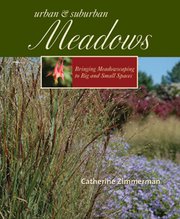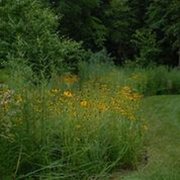Potomac — These days, many of us are searching for alternatives to conventional lawn and garden care, a task that has become increasingly dependent on time and maintenance, as well as pesticides and other poisons. The suburban meadow offers a solution to this problem.
Low-maintenance and chemical-free, meadows eliminate the need for constant yard work while optimizing land use, saving water and preventing soil erosion. Planting a meadow can improve water quality in the community by dispensing with the need for harmful chemicals and fertilizers. And by making use of native wildflowers and grasses, meadows help conserve the natural landscape while complementing and enhancing a home’s natural terrain.
Details
To learn more about meadows, and how to incorporate one into one’s own site, go to https://themeadowpr…">https://themeadowpr… and read about Catherine Zimmerman’s work. Or purchase her book, “Urban & Suburban Meadows,” available through http://Amazon.com">Amazon.com.
Zimmerman is an award-winning director of photography and has more than 30 years experience in documentary filmmaking with an emphasis on education and environmental issues. She is a certified horticulturist and landscape designer. Follow her on Facebook at https://www.faceboo…">https://www.faceboo… or read her blog about planting a meadow at http://nativeplantw….">http://nativeplantw….
According to meadow expert Catherine Zimmerman, author of “Urban and Suburban Meadows,” and currently at work on two projects in Potomac, what she terms “meadow-scaping” can liberate residents from their lawn’s virtual monoculture and restore healthy, sustainable ecosystems to back yards.
“If you think about things in life, diversity is usually the most healthy,” Zimmerman said. “Traditional lawns allow little opportunity for biodiversity, let alone plant or insect life.” Aside from the regular applications of pesticides and fertilizers needed to sustain them, lawns require constant maintenance while placing heavy demands on water supplies “Water is going to become very precious in the future,” said Zimmerman.
LAWNS VERSUS MEADOWS
Lawns planted with non-native species such as Kentucky bluegrass engage people in an ongoing battle to maintain a landscape that requires constant monitoring and irrigation. According to Zimmerman, most all lawn seed sold today originated in other parts of the world. Kentucky bluegrass, native to Europe and northern Asia, is actually a cool-season species that goes dormant in the dry summer months, making it a poor choice for local hot, humid conditions.
Many native grasses, on the other hand, are drought tolerant and can be used to establish low-maintenance, low-cost alternatives to the traditional lawn. Examples include Little Bluestem grass, Indian grass and Box Sedge. Buffalo grass is a warm-season species that is sod forming, with roots that can extend as deep as seven feet into the ground. According to the Colorado Master Gardener Program “Garden Notes,” buffalo grass varieties can remain green and attractive on 50 to 75 percent less irrigation than Kentucky bluegrass.
Even the ubiquitous white clover can offer a viable option for lawn enthusiasts who are trying to wean themselves from chemicals. A member of the pea family, clover uses bacteria in its root system to convert nitrogen into fertilizer in the soil. A rapid spreader, it can crowd out broadleaf weeds while growing harmoniously with grass. Drought-tolerant clover also keeps its cool green color even in the hottest summer months.
To meet growing demand, many nurseries are now developing native grass seed mixes, adapted to specific regions that require little attention once rooted. This adaptation makes watering infrequent and requires no fertilizer input. Mowing is minimal, required as infrequently as once or twice a year, or once a month for a more manicured appearance.
Compared with the native lawn, meadows deliver even more low-cost, low-maintenance advantages. When successfully modeled after plant communities already existing in the area, they can stabilize soil, control storm run-off and make watering a bygone chore. Ultimately self-sustaining, the suburban meadow is a smaller and more intentioned space than traditional meadows. It is often used in conjunction with natural lawns.
A meadow designed for the urban/suburban landscape typically consists of more grasses than flowers. Zimmerman stresses that while flowers are beautiful, the meadow should actually comprise at least 60 percent grasses. Grasses aid in stabilizing soil while supporting taller meadow flowers. They are also capable of surviving drought and act as food and shelter for local wildlife.
During its crucial developmental phase, usually two to three years, the meadow adapts and aligns itself with conditions native to its environment. This enables complex relationships to form between the meadow’s plants, animals and other microorganisms. Over time, each meadow develops into its own unique ecosystem, attracting scores of insects and wildlife. Zimmerman enjoys watching the yellow finches grazing on the seed heads in her own suburban meadow. Her yard now provides a habitat for disparate species where before there was none.
THE BEST TIME TO PLANT a meadow is in the fall, or before the first frost. Sowing seeds in the fall allows for them to break their dormancy. Warm, wet spring weather induces them to germinate. When seeding, Zimmerman recommends installing an annual “nurse crop” to protect tender seedlings and to prevent erosion. Some suggestions are annual oats for spring seeding or winter wheat when seeding in the fall. Another option is to cover the space with straw.
For bigger projects of two acres or more, mechanical seeding works best. The no till drill seeder, hooked to the back of a tractor, places seeds in little slits in the soil. Advantages to this method are that there is minimal soil disruption, which could bring weeds to the surface. It also allows for precise placement of the seeds. Since the typical meadow plant seed is very small, common practice is to mix the seeds with another inert material like kitty litter or sawdust so they all don’t drop from the seeder at once.
For those with an acre or less to plant, which represents the typical suburban/urban meadow size, hand-broadcasting remains the most effective method of planting. No need to add kitty litter to the mix, but it works best to sow each species individually because meadow seeds generally come in different sizes and weights.
A standard seed mix comprises 25 species, making meadow seed more expensive than grass seed initially. However, over the long term the emerging seedlings are much cheaper to maintain, requiring little to no watering or mowing. “Over time, you really start to see you’re saving money,” said Zimmerman. “Plus you are providing a habitat for insects and birds that are becoming extinct because there are no longer places left for them to feed and make nests.”
While seeds are the most economical way to go, “plugs” or live plants bought in flats or containers, are also an option, especially for those who don’t want to wait the two to three years it takes for the meadow to establish. Appropriate planting tools can be determined based on number of plants, soil type and soil conditions. While a planted meadow requires less mowing in the first two to three years to control weeds, after it is established, maintenance is the same as the seeded meadow, with mowing required only once annually. Zimmerman sometimes recommends a combination of seeds and plugs, with placement of grown plants in the foreground to hide seedlings as they grow.
Potomac residents Bill and Diana Conway are calling upon Zimmerman’s skills to design a meadow in their backyard this fall, just in time for planting. They’re planning to cover approximately a half-acre of their large property. The couple loves the idea of bringing in plants that will support native pollinators such as butterflies and bees. They are also excited about the idea of mowing a large chunk of their property only once a year.
The Conways will be hand-broadcasting seed and settling down for the two to three year wait until the meadow is established. “We are looking forward to creating a visual focal point from the back of our house and all the back bedrooms,” said Diana Conway. “Plus, we’re tired of paying the mowers.”
Down the street, the Slovers are working with Zimmerman to design three meadow areas. They’re intrigued by the idea of turning a portion of their yard into an area where native plants and flowers can thrive and feed the bees, butterflies and birds. The plan is to use a combination of seeds and plugs so that the meadows have visual impact from the start.
“We know that adding a meadow will not only help conserve the local flora and fauna but will add to our enjoyment of the outdoors as well,” said Katherine Slover. “It’s really better than watching TV.”
CHOOSING A SITE
According to Zimmerman, careful analysis of the prospective site, coupled with correct soil preparation, are the two most important tasks in creating a meadow garden. Site analysis allows for the selection of plants that are best suited to the environment, while good preparation is essential to controlling weeds and aiding in establishment of the plants. “What species you end up putting in is secondary. Once you understand the site, you will know what plants are most suitable,” Zimmerman said, adding, “It is very important to start out correctly.”
For instance, through simple observation, the homeowner can get a good idea of where the water collects on their property and which spots remain damp or dry. Tops of hills are typically dry, while the bottoms of hills are most likely to exhibit wetter conditions.
While the best place to establish a meadow is typically in an open, sunny and well-drained area, successful meadows have been designed for wet, low-lying spots as well. Many plants traditionally associated with meadows are tall, but meadow plants can be small as well, sometime measuring only 2-4” in size. The range in height of meadow plants makes designing even the smallest meadow gardens possible. According to Zimmerman, most suburban meadows are 1/3 of an acre or less in size.
Following are some of the best meadow sites:
- Areas of new construction where the soil is either rocky or poor
- Lawns
- Ground where trees have been removed
- Land where woods and lawn meet
- Slopes where there is an erosion problem and mowing is difficult
- Areas where heavy rains cause flooding.
SUITABLE PLANTS
Many nurseries offer meadow plants and seed mixes suitable for the Potomac area. Zimmerman recommends the North Creek Nurseries’ wholesalers catalogue as a great resource for plants at www.northcreeknurseries.com. The website features color photos and meadow layouts. Check to make sure the plants you’re choosing aren’t on the state’s noxious weeds lists. For a list of native plant and seeds, go to the Lady Bird Johnson Wildflower Center plant database at www.wildflower.org/plants or www.nativeseednetwork.org for information on all aspects of native seed.


